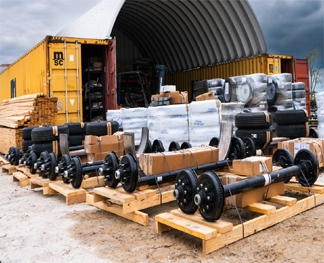
2-Weeks | Limited Time Offer
All our enclosed trailer sizes are discounted for the next 2 weeks

Selecting an enclosed trailer is a significant investment, one that demands more than a quick glance at a price tag. The decision hinges on a crucial factor: size. Choosing the right dimensions isn’t just about fitting your cargo; it’s about ensuring safety, maximizing efficiency, and protecting your investment for years to come. With the U.S. Trailer Market valued at USD 5.60 Billion in 2024, it’s clear that these versatile tools are essential for countless individuals and businesses. An enclosed cargo trailer that’s too small leads to frustratingly inefficient trips and potential damage to your goods. Conversely, a trailer that’s too large becomes a cumbersome, fuel-guzzling burden that’s difficult to maneuver and store.
The correct trailer size directly impacts your operational safety. An overloaded trailer can strain your tow vehicle’s engine and brakes, leading to dangerous situations on the road. The right size ensures your payload capacity is respected and weight is distributed properly. Efficiency is also key; a perfectly sized cargo trailer minimizes wind resistance, improves fuel economy, and reduces wear and tear on your vehicle. Finally, the initial purchase price, insurance, and maintenance costs all scale with the trailer’s dimensions. A thoughtful choice balances your immediate needs with long-term ownership costs, ensuring you get the most value from your asset.
This guide will demystify the process of selecting the perfect enclosed trailer. We will break down the essential factors you need to consider, from understanding the nuances of trailer dimensions to matching your choice with your specific hauling application and tow vehicle.

How wall thickness and wheel wells impact usable space within a 6×12 enclosed trailer. Note the difference between nominal and actual dimensions.
When you see a trailer listed as a “6×12,” the numbers represent the approximate interior dimensions: 6 feet wide by 12 feet long. This simple format is the industry standard for defining the primary cargo box. However, it’s crucial to understand that these are nominal figures. The actual usable space is influenced by wall construction, interior finishing, and features like wheel wells.
Never confuse a trailer’s advertised size with its total exterior footprint. The overall length includes the tongue and hitch, while the exterior width includes fenders and tires. These external measurements are vital for determining if the trailer will fit in your storage space, garage, or navigate tight job sites. Always confirm both the interior (usable cargo space) and exterior (total footprint) dimensions before making a purchase.
While length and width are primary metrics, true cargo volume is measured in cubic feet. This is calculated by multiplying the interior length, width, and height. Understanding your required cubic feet is especially important when hauling bulky, stackable items. A trailer with a higher interior height can dramatically increase your total cargo volume without increasing its footprint, making it a more efficient hauler.
Enclosed trailers are typically categorized by width, with common sizes being 5′, 6′, 7′, and 8.5′. The length can then vary significantly within each width category.
Your usage pattern should influence your size choice. For occasional, local trips, a smaller single axle trailer may suffice. For daily use or long-distance hauling, a larger, more stable tandem axle trailer is often a better investment. Frequent hauling demands durability and features that support stability and safety on the highway, such as electric brakes and a robust suspension system.
Before diving into specs, you must clearly define your purpose. Are you a contractor hauling tools, a car enthusiast transporting a vehicle, or an entrepreneur launching a mobile business? Each application has unique dimensional and feature requirements.
The nature of your cargo is the single most important factor. Measure your largest pieces of equipment. If you’re starting one of many mobile businesses, map out the interior layout you’ll need. For enclosed car trailers, ensure both the length and width accommodate your vehicle with extra room for securing it. The growing light car trailer market, valued at USD 1.5 billion in 2023, shows a strong demand for correctly sized vehicle haulers.
Your budget encompasses more than the sticker price. Factor in taxes, registration, insurance, and potential maintenance. Larger trailers with tandem axles and more features will have a higher upfront cost and may require more expensive tires and upkeep. Establish a realistic budget that covers both the purchase and the long-term costs of ownership.
Let’s connect common trailer dimensions to real-world uses to help you visualize your ideal fit.
These compact trailers are perfect for homeowners, hobbyists, and small businesses. A 5×8 trailer is excellent for hauling a single motorcycle, camping gear, or tools for a small handyman service. They are typically built on a single axle, making them lightweight and easy to tow with an SUV or small pickup truck. Their smaller size makes them easy to maneuver in tight spaces and store in a standard garage.
This is the sweet spot for versatility and capability. A 6×12 or 7×14 enclosed cargo trailer is a favorite among landscapers and contractors. They can easily accommodate zero-turn mowers, building materials, and a wide array of tools. Most trailers in this range, especially the 7-foot wide models, feature tandem axles for increased payload capacity and stability, making them suitable for heavier loads and highway travel. A 7×16 trailer provides ample space for UTVs, multiple motorcycles, or a more spacious mobile workshop.
At 8.5 feet wide, these trailers are built for serious hauling. They are the standard for enclosed car trailers, race teams, and large-scale mobile businesses. An 8.5×20 can comfortably fit most cars, while an 8.5×24 provides extra room for a workbench or tool storage. These large enclosed trailers almost exclusively use heavy-duty tandem axles (or even triple axles for the longest models) and are equipped with robust electric brakes to handle their substantial weight capacity.
Beyond simple dimensions, you must understand the technical specs that govern a trailer’s performance and safety.
Three key terms are non-negotiable:
The axle configuration is critical for determining a trailer’s weight capacity and on-road behavior.
Your trailer choice is limited by your tow vehicle. Every pickup truck, SUV, or van has a manufacturer-specified towing capacity—the maximum weight it can safely pull. The trailer’s GVWR must never exceed your vehicle’s towing capacity. Check your vehicle’s owner’s manual or the sticker on the driver’s side door jamb to find this critical number.
For smaller, single axle trailers, the tow vehicle’s brakes may be sufficient. However, for any trailer with a higher GVWR (often 3,000 lbs or more, depending on state law), electric brakes are a legal and safety requirement. These systems are connected to a controller in the tow vehicle and apply the trailer’s brakes in sync with your own, providing immense stopping power and control, especially with heavy loads.
The right size is also about usability. Consider features that enhance the functionality of your chosen dimensions.
Standard interior height is often around 6′ to 6’6″. If you’re hauling tall equipment like a UTV with a roll cage or plan to stand and work inside your trailer for a mobile business, opting for extra height (e.g., 7′) is essential. This dramatically increases your cubic feet of storage and improves comfort.
How you get cargo in and out is paramount.
Choosing the right enclosed trailer is a methodical process, not a guess. It begins with a clear understanding of what you need to haul, how often you’ll haul it, and the capabilities of your tow vehicle. By carefully considering the interplay between trailer dimensions (width, length, and interior height), technical specifications (GVWR, payload capacity), and axle configuration (single axle vs. tandem axles), you can make an informed decision that ensures safety, efficiency, and long-term value. Don’t forget to account for practical features like a rear ramp door or an aluminum roof that enhance daily usability. Armed with this knowledge, you are now equipped to navigate the options from trusted manufacturers like Four Winds Trailers and select the perfect enclosed cargo trailer that will serve as a reliable partner for your work or passion for years to come.
Share this article
10 Reasons why you should Buy from Make My Trailer
Factory Direct Pricing
We cut out the middleman so you get the best deal possible—affordable trailers without hidden markups.
5-Year Warranty
Every trailer comes backed with a powerful warranty for peace of mind and long-term protection.
Huge In-Stock Inventory
Unlike many competitors, we keep stock ready-to-go so you don’t have to wait months for a build.
Custom Builds Available
Need something unique? We build to your specs so you get exactly what you want, from size to special features.
Trusted Manufacturers
We work with leading trailer manufacturers like Diamond Cargo, Nationcraft, Anvil Cargo, Quality Cargo, and South Georgia Cargo—brands customers trust.
Proven Track Record
Over 9 years in business, more than 5,000 trailers sold, and hundreds of positive reviews prove our commitment to customer satisfaction.
Multiple Size Options
From compact 4×6 utility trailers to massive 8.5×36 haulers, we have the right trailer for every hauling need.
Durable Construction
Our trailers are built with high-quality materials—steel tube frames, PolyCore options, LED lighting, and one-piece roofs for lasting strength.
Easy Buying Process
Get a quote your way: call, text, email, or build it online. Once approved, we handle the rest until pick-up day.
Customer-First Service
We take care of our customers before and after the sale—quick responses, clear communication, and support you won’t get from big-box competitors.
Contact Us Now:
Pickup Address:
91 Harvey Vickers Road, Douglas, GA, 31535